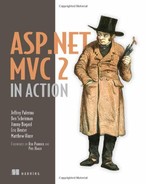Part 4. Cross-cutting advanced topics
Now that you’ve made it from part 1 through part 3, you have a deep understanding of the parts of ASP.NET MVC as well as how to apply abstract patterns when your usage of the framework changes. You understand how programming for small web applications differs from programming for applications with many screens. You understand the techniques to employ when programming alone, and what should be done when programming ASP.NET MVC in a team setting.
Part 4 consists of several cross-cutting advanced topics. Chapter 24 looks at debugging routes, an important technique once an application starts incorporating custom routes. Chapter 25 introduces Visual Studio customization for ASP.NET MVC using templates. Chapter 26 talks about testing techniques, including routes, controllers, model binders, and other extension points. Finally, part 4 concludes with a recipe chapter that pulls together many of the concepts covered in this book, creating an autocomplete text box.
At the conclusion of part 4, you’ll stand on a solid foundation of knowledge enabling you to employ ASP.NET MVC in a variety of environments. As you go through part 4, stop and take the time to try out the code provided with each chapter. Consider modifying the provided examples to gain a deeper understanding of each technique and turn these techniques into skills.
Part 4 assumes that you’ve absorbed the entirety of the ASP.NET MVC Framework, so it is best to read this only after consuming the material in parts 1-3. If you feel comfortable with the ASP.NET MVC framework, please continue into chapter 24.
